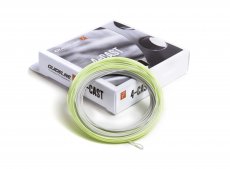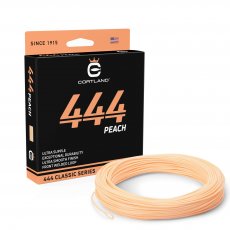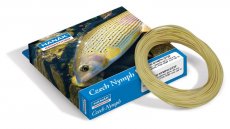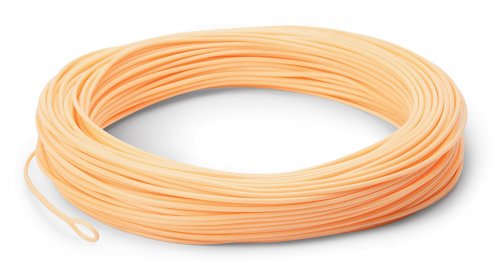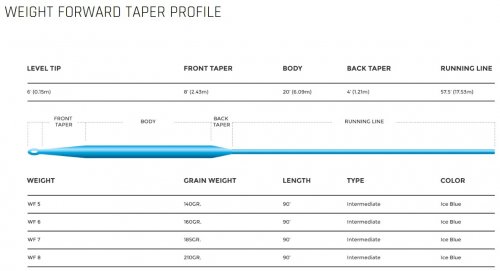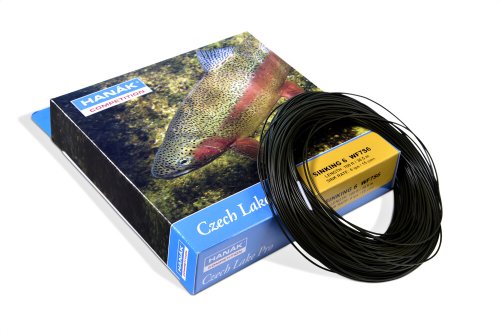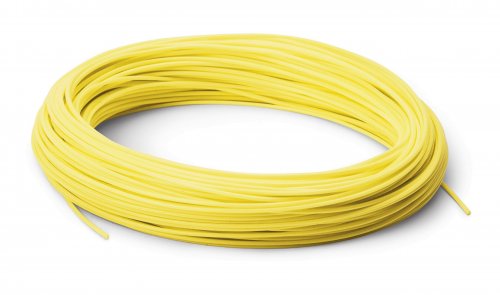This brief set of paragraphs is intended to help you to choose the fly line.
Introduction:
Modern fly lines really are a joy to use. Their technical specifications confirm the huge input of sophisticated technology in their design and manufacture. There is a line for every purpose - and this fact creates a difficulty... it is sometimes difficult for novice fly-fishers to select the most appropriate line for their intended use. Choosing the correct line to present your fly (or flies) with delicacy, sometimes at considerable distance, then at the correct depth, is a complex three-dimensional formula - and will influence success and casting pleasure. There is no single answer... what suits one fly-fisher, may not suit another! These notes are aimed at helping you to assess which line(s) you may need.
Length:
The overall length of fly lines varies with some as short as 25 metres and some as long as 40 metres. The overall length is likely to impact on how far the line will cast although, in normal practice, few fly-fishers would require a casting line of greater than 40 metres (almost everyone uses 'backing line' to extend the distance which a fish may run to.)
Profile:
There are many variations of line 'profile'. Historically, silk fly lines were 'level' in that they had constant thickness throughout their length. With the development of modern plastic coated lines the profile could be designed to aid casting having a fine tip (to aid delicate presentation) and a tapered section made from heavier line to 'load' the fly-rod, transferring energy effectively into the line.
Double taper:
The profile may be equally tapered (i.e., the front and back taper are mirror images of each other)...this is termed 'double taper' (DT). It is possible to reverse a double taper line if it becomes worn.
Weight forward:
The most popular modern profile is 'weight forward' (WF) which consists of a fine front (presentation section) with a heavier torpedo-shape tapering to the rear where the line if much thinner (called running line). There are many variations of weight-forward some with very prominent head thickness and others with a more subtle profile.
Sink-Rate:
Fly lines may be made to sink or stay afloat by the addition of the appropriate components during manufacture. There is a bewildering array of sink-rates including : neutral density, sub-surface, intermediate, slow-sink, medium-sink and fast-sink categories. A very popular line presently is the 'sink-tip' which is a floating line throughout most of its length with a portion of its tip made of sinking line (to present the flies just under the surface). There are lines with interchangeable multi-tips which make selection of sink-rate easier.
Weight:
There is a system (provided by line manufacturers) of defining line-weight to match the loading specification of the rod. The system is called AFTMA and ranges between lightweight (eg. AFTM 2, 3,and 4 -weight) lines to heavy-weight (eg. AFTM 11, 12 and 13-weight). By selecting lines which match the rod rating, a balance may be achieved.
Constituent Material:
Modern fly-lines are made from a core of synthetic braided fibre loaded with a supple plastic material then polished very smooth with a fine, hard-wearing, low-friction coating. Lines are designed to be limp enough to cast with ease, but stiff enough to transmit the energy of the cast to the line tip (termed 'turn-over') - it is a design compromise. This is also influenced by the ambient temperature - some lines are designed for use in the tropics where the plastic becomes flexible in warm water (but would be too stiff in cold conditions). The materials used at different points along the line determine where the weight and loading occurs. Stretch is minimised so that hook-up is direct and contact with fish is improved.
Colour:
A source of considerable debate, the colour of fly-lines has several aspects. When viewed from below (as fish may see it) a dark line might be more obvious than a light coloured one - this 'fact' (there is much debate about whether it is a fact!) means that many floating lines are made from light coloured materials. This of course, also makes the line easier to see by the angler who may benefit from seeing his line move when a fish takes (or see where it is in relation to a targeted fish). Manufacturers tend to make sinking lines of dark-coloured material/coating (often, the darker the colour - the deeper the sink rate). There is a helpful design in some recent lines where they have the front taper in a different colour from the running line - this aids casting by making it easier to observe the sweet-spot where the rod is loaded optimally with line.








